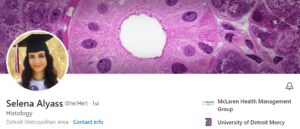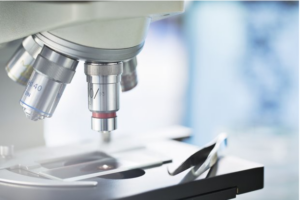Detroit Mercy Alum Selena Alyass, now has a career as a Histotechnologist. Pre-Health Advisor, Carmen Gamlin sat down with Selena for a 3-Question Interview to discuss the role of Histotechnology in relation to healthcare, her road to becoming a Histotechnologist and fond memories of her time as a Detroit Mercy Titan.
So it’s a team effort. It’s something I like about it. It’s like you’re independent, you’re working by yourself, but you need to get your portion done…you’re working all together in this lab but you’re working on your own singular thing at a time.

1. I believe that we only know what we have been exposed to. Many Titans have not been exposed to the career of a Histotechnologist. What do you do ?
Selena begin the interview by discussing what a histotechnologist does and their role in patient care. Essentially, Histo Techs prepare tissue samples to be tested. She provides a general overview of this process.
So we begin with receiving tissue samples. So if you ever had a biopsy done, that’s what we get…So those tissue samples come in a fixative, which we then place in our processing machines and continue fixation and these subsequent steps. After they come off these processors, we embed the tissue in a mold and making sure whatever part of the tissue the pathologist is going to want to examine, making sure they are placed the right way. Once those are cooled down, we take those blocks of tissue now and put them in a microtome…and that’s when we start to section the tissue and cut it up, creating very thin sections of tissues, forming a ribbon which we then place into a warm water bath. We take a microscope slide and pick that section of tissue and once we do that, have 40-60 of these slides we can place them onto our stainers and stain them with H&E Staining.
Later on if a pathologist needs some more staining, like special staining or immunostaining, they will order those stains so it helps them diagnose whatever they need to diagnose for a patient.
2. Launching careers after a science bachelors is exciting. Perhaps there is a class or two that you know best prepared you for your current career.
Selena credits Detroit Mercy’s Histology Lecture and Lab course for introducing her to Histology and laying out the foundation for her to be successful in her current career. She expresses joy and gratefulness for deciding to take both courses stating that she originally only took the courses because she needed the extra Biology Credits!
The Histology lecture and lab is what introduced me into becoming a Histo Tech. The lab was crucial, very important to what I do. In the lab we got to embed the tissue, we started with everything from like dissecting from rat, picking our fixatives to embedding that tissue and then using a microtome. I wasn’t that great using the microtome back then, I’ve definitely gotten better but that lab is what gave me that structure to like everything I know now. It gave me all that background knowledge. So without that, I would not be where I am now.
3. Share a fond memory of your time as an undergraduate at the University of Detroit Mercy.
Selena shares memories of undergrad with her best friend from high school. She tell of times of studying all around the campus and how her and her best friend went through many of the lab courses together.
So for me, when I look back at school, I remember all my memories with my best friend. We were both Biology majors and so we had to go through all of this together…I think we tested out every study room on campus to figure out our favorites. So we will be in there cramming before an exam, teaching each other things, helping each other out and so it was nice to be able to go through that with her.
Connect with Selena Alyass on LinkedIn

